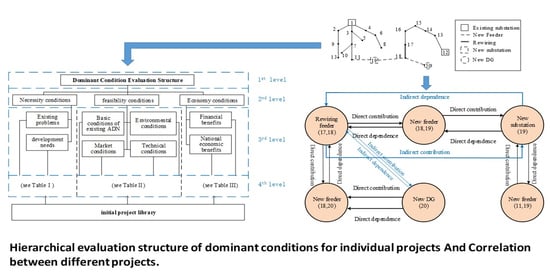A Novel Optimization Method for a Multi-Year Planning Scheme of an Active Distribution Network in a Large Planning Zone
Abstract
1. Introduction
- Propose the concepts of the boundary condition and dominant condition and put forward the corresponding evaluation method to assess the ideal performance of individual projects.
- Propose the concepts of the contribution index (CI) and dependence index (DI) to quantify the correlation among ADN planning projects.
- Propose a methodology to prioritize the planning projects during the planning period in conjunction with an assessment of individual projects and an assessment of the correlation among the projects.
- Put forward a rolling optimization strategy for multi-year ADN planning, where the project library, project conditions, and project correlation are updated annually. Therefore, the proposed optimization model can be adapted to long-term planning problems.
2. Condition Set and Condition Scoring of ADN Planning Projects
2.1. Definitions of Conditions of ADN Planning Projects
- (1)
- Policy:
- (2)
- Renewable energy development plan:
- (3)
- Regional economic and social development planning:
- (4)
- Environmental protection requirements:
- (5)
- The development scale and technical equipment level of the existing distribution network in the planning area.
- (6)
- Development plan of the grid company.
- (7)
- The scale of ADN investment.
2.2. Boundary Conditions
2.3. Dominant Conditions
- (1)
- Necessity: the necessary condition is used to analyze the severity and urgency of the problem addressed by a distribution network project and the extent to which this project can resolve or improve the problem. The necessary condition evaluation of the distribution network project is mainly carried out from two aspects: the existing problems and the development needs, as shown in Table 1.
- (2)
- Feasibility: the purpose of feasibility evaluation is to analyze the possibility of successful project implementation. The feasibility conditions shown in Table 2 are clustered into four categories.
- (3)
- Economy: the economic condition assessment analyzes and calculates the inputs and outputs of the distribution network projects, thereby measuring the economic reasonableness and economic benefits of the suggested project. The economic condition evaluation of distribution network projects includes two levels: from the perspective of the power company, calculate the financial benefits and expenses, whereby planners can evaluate the financial rationality of the project; from the perspective of the overall economic benefits of the planning area, analyze the project’s contribution to the national economy, thereby evaluating the macroeconomic rationality of the project. The set of economic conditions is displayed in Table 3.
2.4. Principle of Condition Scoring
- (1)
- Improved method for weight calculation
- (a)
- Calculate the interference matrix Pwhere wi and wj are elements of .
- (b)
- If P is a zero matrix, then A has complete consistency. By contrast, the larger the pij, the greater the influence of the corresponding aij on the inconsistency of A. Find out , and record the values of s and t.
- (c)
- Modify A and obtain matrix G = {gij}n×n through (3)
- (d)
- Check the consistency of this modified judgment matrix G. If G passes the check, the weights can be solved directly by the eigenvalue method; if it fails the check, return to step (b). If the verification still fails after four revisions, consider rebuilding the judgment matrix A.
- (2)
- Calculation of the dominant condition score considering different planners’ opinions.
3. Quantization Method with Correlations for ADN Planning Projects
- (a)
- Set the total contribution value of all projects as CVT, and the initial contribution value of each project in the initial project library as CVT/N:where is the original contribution score of project i, N is the number of projects in the initial project library.
- (b)
- According to formula (8), perform iterative calculation of the correlation score until iterates have converged.where is the contribution score of project i in the kth iteration, is the set of projects that have a direct dependence on project i, is the element of the Google matrix in correlation evaluation, is the number of projects that project j directly depends on, and is the damping coefficient, which is usually set as 0.85.
4. Rolling Optimization Strategy of ADN Multi-Year Planning Scheme
4.1. The Rolling Optimization Process
4.2. The Rolling Optimization Process
- (1)
- Objective Function:
- (2)
- Constraint conditions:
- (a)
- Latest operation time constraints: assume is the set of projects without a deadline of production, is the collection of projects with a deadline, and ti is the exact year by which project i must be invested. Obviously, each project can only be executed once during the planning horizon; then, the constraints are
- (b)
- Successor constraints: two projects may have a successor relationship due to technical, land, or staffing reasons, which means project j can only be arranged after project i, and once project i is put into production, project j must be invested immediately, as formula (15) showswhere [dit] is the largest integer less than or equal to dit.
- (c)
- Maximum investment constraint:where is the cost of project i, is the max investment budget in year t.
5. Case Study
- (1)
- Calculate the ideal dominant condition score of individual projects
- (2)
- Construct the Google matrix for correlation evaluation and calculate the contribution score of projects. There are 1291 projects in the project library, so set CVT to be 100.
- (3)
- Check the completion status of projects in for project i (i =1,…,1291) and calculate the actual dominant condition score using formula (11) and the comprehensive score of projects using formula (10).
- (4)
- Rank the projects in order of comprehensive score from highest to lowest score, considering the constraint conditions, and obtain the projects to be invested in the following year.
- (5)
- Update Mt and go back to (1), obtaining the optimized planning scheme for the entire planning period.
6. Conclusions
- We addressed the Expansion Planning Scheme Optimization (EPSO) for the optimal planning of large zone ADN projects.
- Considering the multi-year rolling optimization, a detailed mathematical model considering the various features including evaluation, time and locality prioritization, and optimal scheduling of ADN planning projects is established.
- The proposed multi-year planning scheme implementation shows the maximum benefit of the overall social resources in the planning area rather than maximizing the economic efficiency of the grid company or another particular investor.
- The validation of the proposed method and comparisons prove the relevance and augmentation of various advantages, suitability, and effectiveness of the proposed planning scheme, consequently saving more than 10% of the investment than the existing implemented scheme.
- The results provide valuable insights into investment decision-making and greatly help power companies looking for the multi-year planning of ADN projects.
Author Contributions
Funding
Institutional Review Board Statement
Informed Consent Statement
Data Availability Statement
Conflicts of Interest
References
- Ullah, Z.; Elkadeem, M.R.; Wang, S.; Sharshir, S.W.; Azam, M. Planning Optimization and Stochastic Analysis of RE-DGs for Techno-Economic Benefit Maximization in Distribution Networks. Internet Things 2020, 11, 100210. [Google Scholar] [CrossRef]
- Ghadi, M.J.; Rajabi, A.; Ghavidel, S.; Azizivahed, A.; Li, L.; Zhang, J. From Active Distribution Systems to Decentralized Microgrids: A Review on Regulations and Planning Approaches Based on Operational Factors. Appl. Energy 2019, 253, 113543. [Google Scholar] [CrossRef]
- Grond, M.O.W.; Morren, J.; Slootweg, J.G. Integrating Smart Grid Solutions into Distribution Network Planning. In Proceedings of the 2013 IEEE Grenoble Conference, Grenoble, France, 16–20 June 2013; pp. 1–6. [Google Scholar]
- Future Power Distribution Grids: Integration of Renewable Energy, Energy Storage, Electric Vehicles, Superconductor, and Magnetic Bus|IEEE Journals & Magazine|IEEE Xplore. Available online: https://ieeexplore.ieee.org/document/8629960 (accessed on 4 June 2021).
- Martins, V.F.; Borges, C.L.T. Active Distribution Network Integrated Planning Incorporating Distributed Generation and Load Response Uncertainties. IEEE Trans. Power Syst. 2011, 26, 2164–2172. [Google Scholar] [CrossRef]
- Pesaran, M.H.A.; Huy, P.D.; Ramachandaramurthy, V.K. A Review of the Optimal Allocation of Distributed Generation: Objectives, Constraints, Methods, and Algorithms. Renew. Sustain. Energy Rev. 2017, 75, 293–312. [Google Scholar] [CrossRef]
- Energies|Free Full-Text|Electric Distribution System Planning Methodology Considering Distributed Energy Resources: A Contribution towards Real Smart Grid Deployment. Available online: https://www.mdpi.com/1996-1073/14/7/1924 (accessed on 20 May 2021).
- Venkateswaran, V.B.; Saini, D.K.; Sharma, M. Environmental Constrained Optimal Hybrid Energy Storage System Planning for an Indian Distribution Network. IEEE Access 2020, 8, 97793–97808. [Google Scholar] [CrossRef]
- Xiang, Y.; Han, W.; Zhang, J.; Liu, J.; Liu, Y. Optimal Sizing of Energy Storage System in Active Distribution Networks Using Fourier–Legendre Series Based State of Energy Function. IEEE Trans. Power Syst. 2018, 33, 2313–2315. [Google Scholar] [CrossRef]
- Mohammad, A.; Zamora, R.; Lie, T.T. Integration of Electric Vehicles in the Distribution Network: A Review of PV Based Electric Vehicle Modelling. Energies 2020, 13, 4541. [Google Scholar] [CrossRef]
- Vahidinasab, V.; Tabarzadi, M.; Arasteh, H.; Alizadeh, M.I.; Mohammad Beigi, M.; Sheikhzadeh, H.R.; Mehran, K.; Sepasian, M.S. Overview of Electric Energy Distribution Networks Expansion Planning. IEEE Access 2020, 8, 34750–34769. [Google Scholar] [CrossRef]
- Asakura, T.; Genji, T.; Yura, T.; Hayashi, N.; Fukuyama, Y. Long-Term Distribution Network Expansion Planning by Network Reconfiguration and Generation of Construction Plans. IEEE Trans. Power Syst. 2003, 18, 1196–1204. [Google Scholar] [CrossRef]
- Kim, J.-H.; Lee, B.-S.; Kim, C.-H. A Study on the Development of Machine-Learning Based Load Transfer Detection Algorithm for Distribution Planning. Energies 2020, 13, 4358. [Google Scholar] [CrossRef]
- Orths, A.; Schmitt, A.; Styczynski, Z.A.; Verstege, J. Multi-Criteria Optimization Methods for Planning and Operation of Electrical Energy Systems. Electr. Eng. 2001, 83, 251–258. [Google Scholar] [CrossRef]
- Zidan, A.; Shaaban, M.F.; El-Saadany, E.F. Long-Term Multi-Objective Distribution Network Planning by DG Allocation and Feeders’ Reconfiguration. Electr. Power Syst. Res. 2013, 105, 95–104. [Google Scholar] [CrossRef]
- Muñoz-Delgado, G.; Contreras, J.; Arroyo, J.M. Distribution Network Expansion Planning With an Explicit Formulation for Reliability Assessment. IEEE Trans. Power Syst. 2018, 33, 2583–2596. [Google Scholar] [CrossRef]
- Ehsan, A.; Cheng, M.; Yang, Q. Scenario-Based Planning of Active Distribution Systems under Uncertainties of Renewable Generation and Electricity Demand. CSEE J. Power Energy Syst. 2019, 5, 56–62. [Google Scholar] [CrossRef]
- Ribas, J.R.; Arce, M.E.; Sohler, F.A.; Suárez-García, A. Data and Calculation Approach of the Fuzzy AHP Risk Assessment of a Large Hydroelectric Project. Data Brief 2019, 25, 104294. [Google Scholar] [CrossRef] [PubMed]
- Ribas, J.R.; Arce, M.E.; Sohler, F.A.; Suárez-García, A. Multi-Criteria Risk Assessment: Case Study of a Large Hydroelectric Project. J. Clean. Prod. 2019, 227, 237–247. [Google Scholar] [CrossRef]
- Ma, Q.; Wang, B.; Hu, W.; Cheng, L.; Ji, S. Study on Evaluation and Decision Optimization of Distribution Network Construction and Innovation Reconstruction Projects. Power Syst. Clean Energy 2015, 31, 11–17. [Google Scholar]
- Zangeneh, A.; Jadid, S.; Rahimi-Kian, A. A Hierarchical Decision Making Model for the Prioritization of Distributed Generation Technologies: A Case Study for Iran. Energy Policy 2009, 37, 5752–5763. [Google Scholar] [CrossRef]
- Huang, H.; Wu, Z.; Ju, J.; Zhang, B.; Wang, X.; Pan, Y.; Zheng, H.; Zhao, Z. Research on Precision Investment Strategy of Distribution Network Based on Data Mining Technology. Zhejiang Electr. Power 2019, 38, 92–97. [Google Scholar]
- Wang, W.; Liu, Y.; Xia, R. Research on the evaluation system of distribution network planning based on improved AHP. Electron. Meas. Technol. 2019, 42, 24–28. [Google Scholar]
- Liu, N.; Ma, L.; Zhu, T. Synthetical Assessment on Distribution Network Planning Scheme Considering Anti-Disaster Ability and Regional Characteristics. Power Syst. Technol. 2012, 36, 219–225. [Google Scholar]
- Chen, X.; Lv, J.; McElroy, M.B.; Han, X.; Nielsen, C.P.; Wen, J. Power System Capacity Expansion Under Higher Penetration of Renewables Considering Flexibility Constraints and Low Carbon Policies. IEEE Trans. Power Syst. 2018, 33, 6240–6253. [Google Scholar] [CrossRef]
- Mai, T.; Wiser, R.; Sandor, D.; Brinkman, G.; Heath, G.; Denholm, P.; Hostick, D.J.; Darghouth, N.; Schlosser, A.; Strzepek, K. Renewable Electricity Futures Study. Volume 1: Exploration of High-Penetration Renewable Electricity Futures; National Renewable Energy Laboratory: Golden, CO, USA, 2012. [Google Scholar]
- Liang, Z.; Chen, H.; Chen, S.; Lin, Z.; Kang, C. Probability-Driven Transmission Expansion Planning with High-Penetration Renewable Power Generation: A Case Study in Northwestern China. Appl. Energy 2019, 255, 113610. [Google Scholar] [CrossRef]
- Liu, F. Study on Investment Efficiency Evaluation System for Distribution Networks Based on Investment Correlation Analysis. Zhejiang Electr. Power 2016, 35, 68–71. [Google Scholar]
- Page, L.; Brin, S.; Motwani, R.; Winograd, T. The PageRank Citation Ranking: Bringing Order to the Web. Available online: http://ilpubs.stanford.edu:8090/422/ (accessed on 13 April 2021).
- Langville, A.N.; Meyer, C.D. Google’s PageRank and beyond: The Science of Search Engine Rankings; Princeton University Press: Princeton, NJ, USA, 2006; ISBN 978-0-691-12202-1. [Google Scholar]
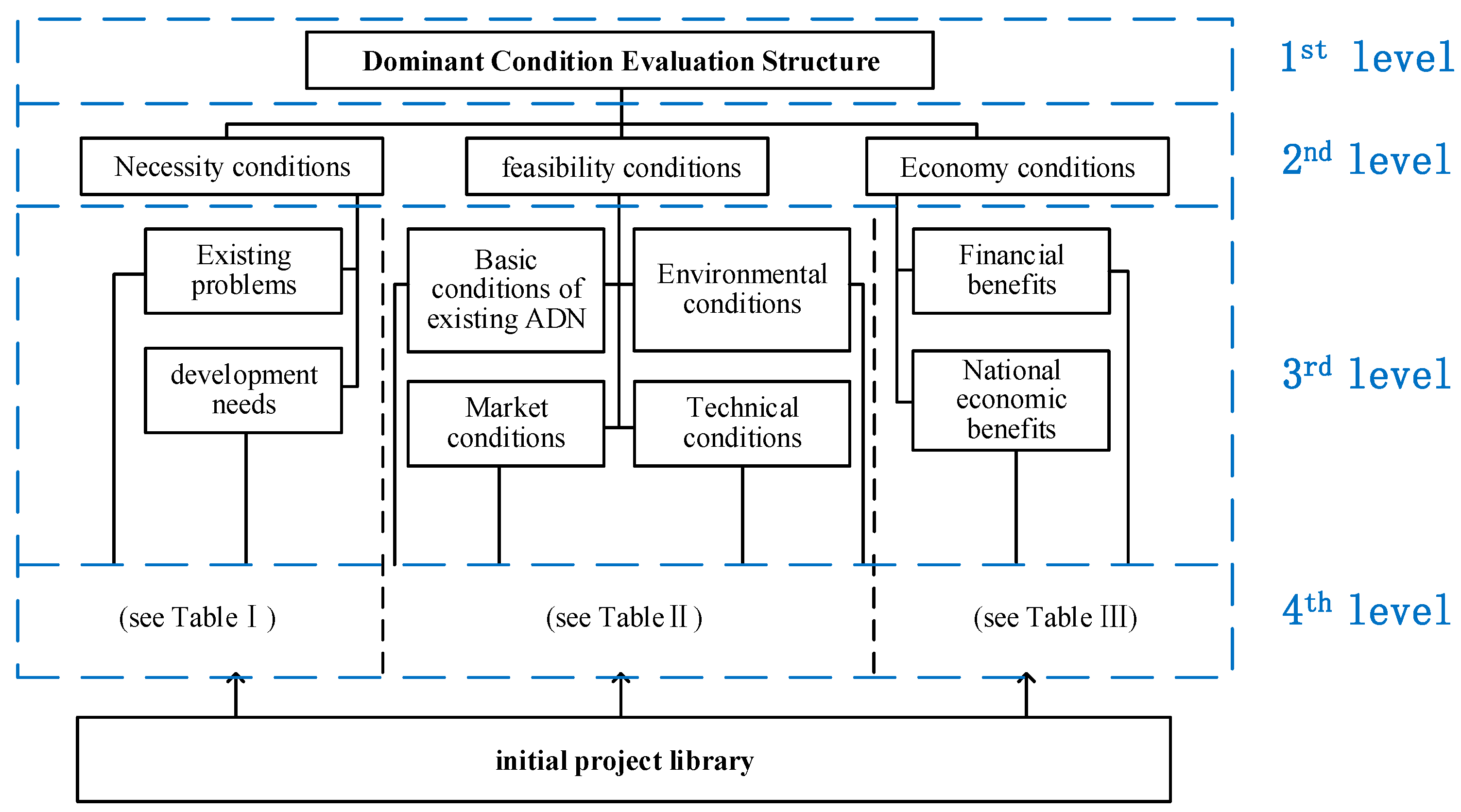

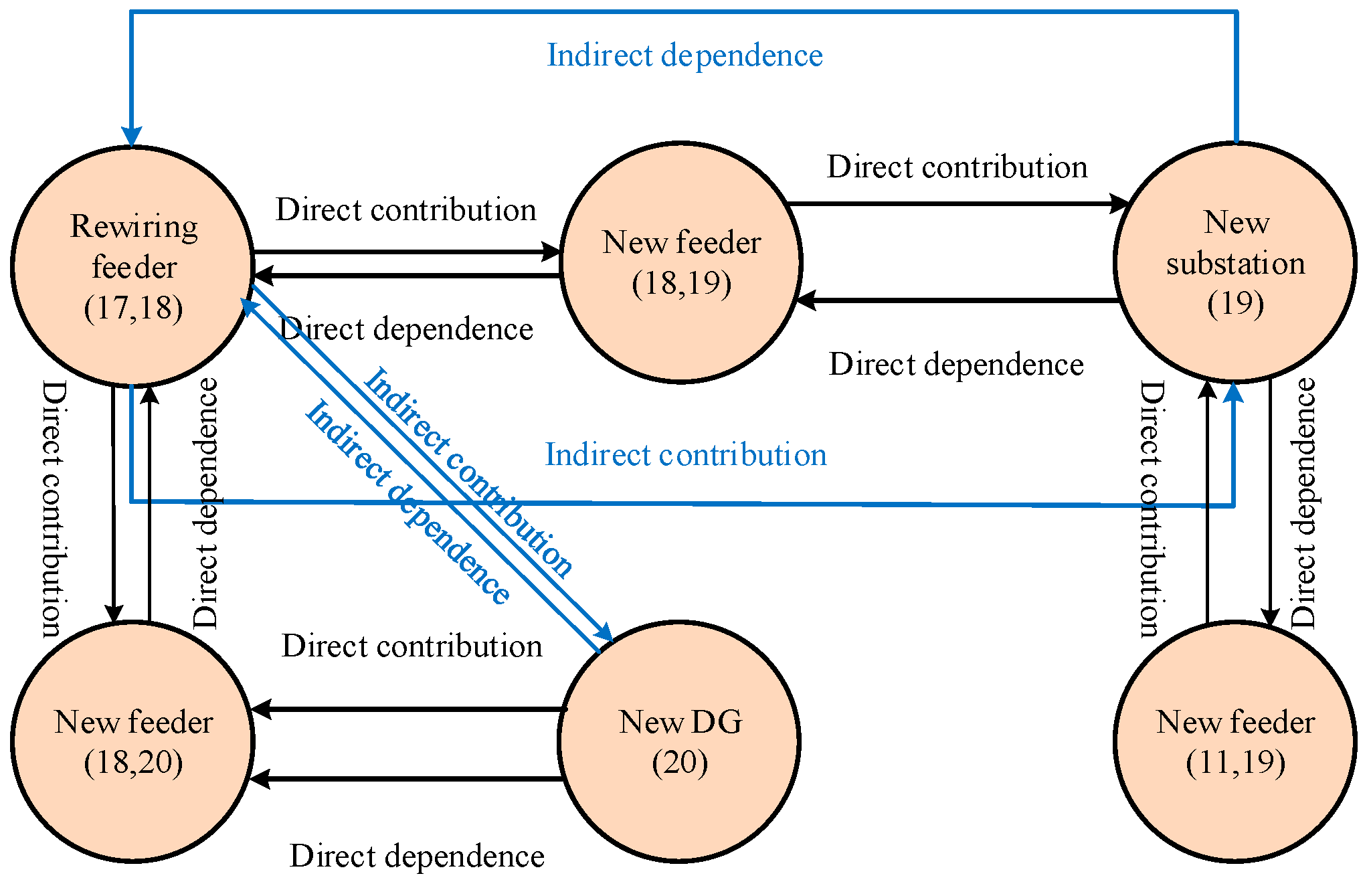
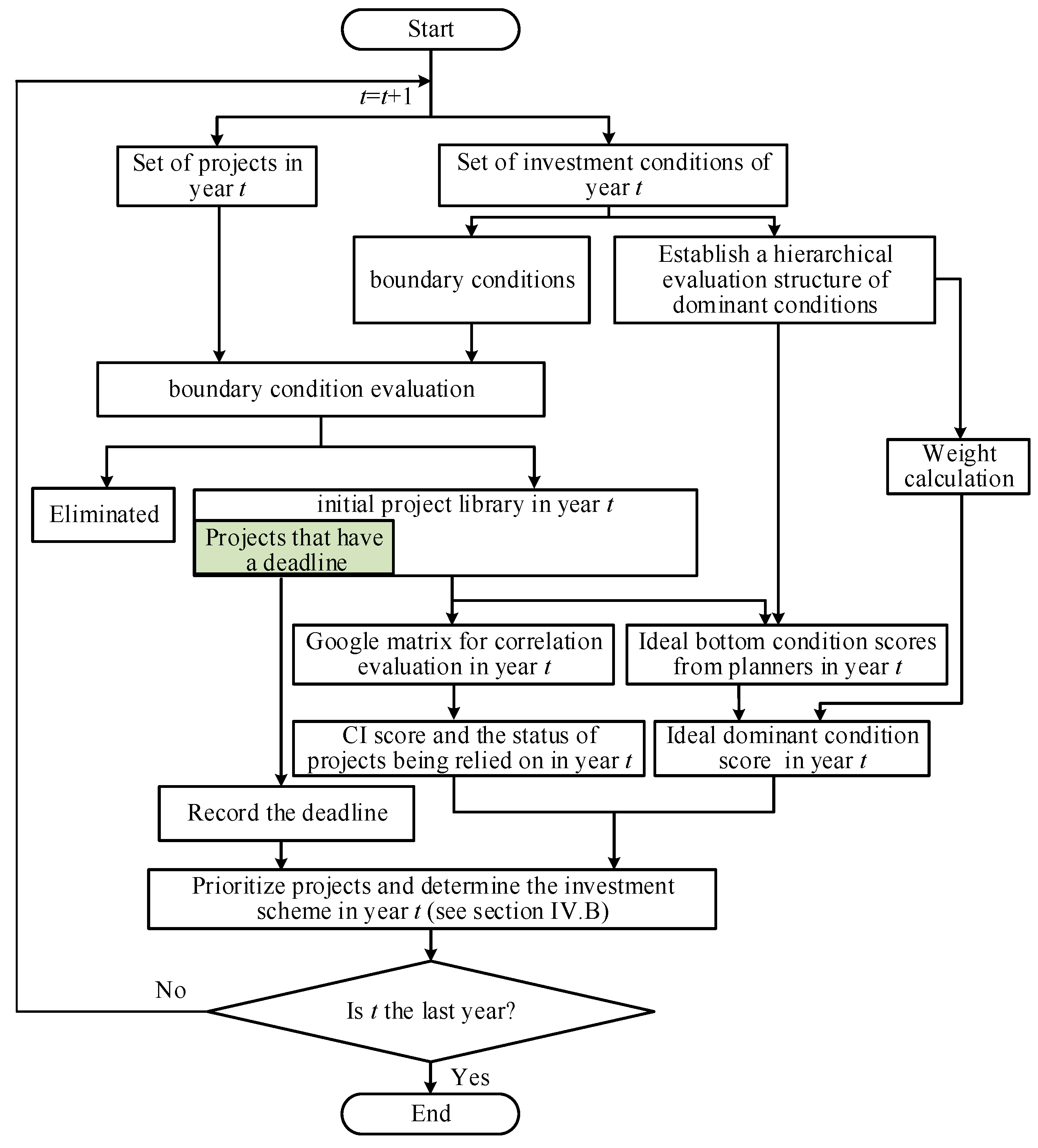
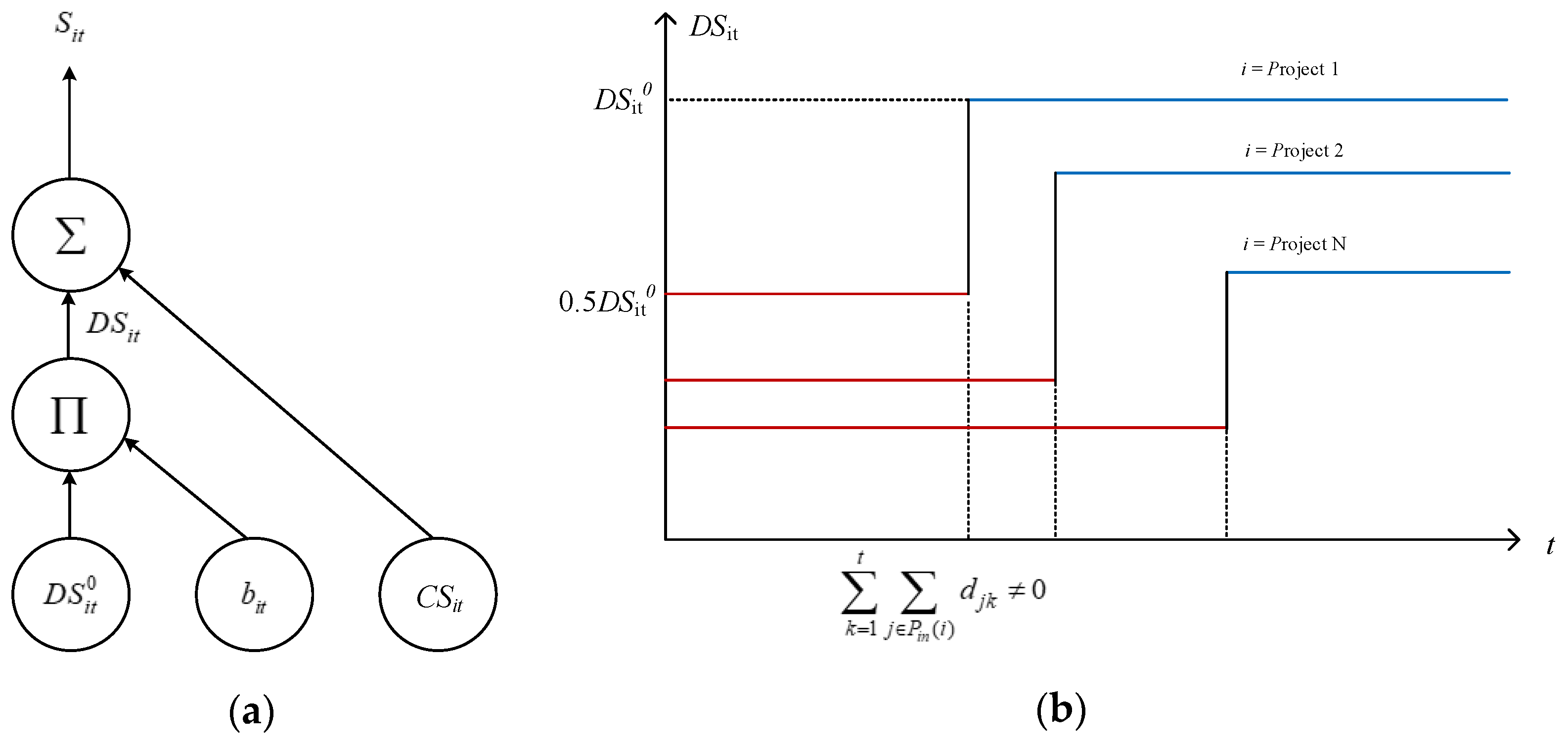
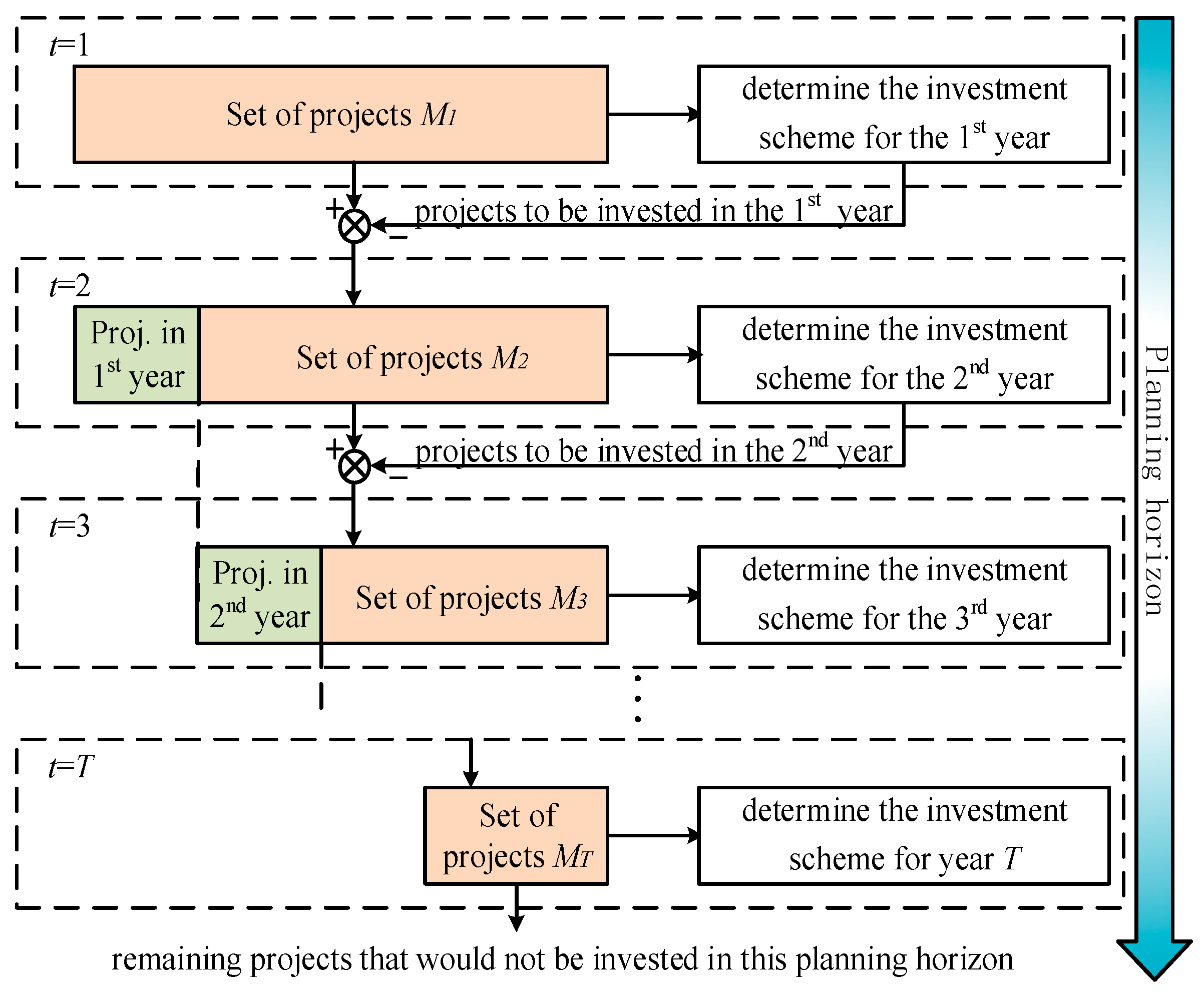
| Third Level | Fourth Level |
|---|---|
| Existing problems | Solving equipment overload Improving low voltage Strengthening the grid structure Supporting power delivery Replacing old equipment Anti-Disaster Meeting environmental protection requirements |
| Development needs | Meeting load growth Satisfying the development planning requirements of the power company Meeting policy requirements |
| Third Level | Fourth Level |
|---|---|
| Conditions of existing distribution network | Support from the existing distribution network |
| Market conditions | Coordination between market demand and project scale |
| Technical conditions | Technology applicability |
| Third Level | Fourth Level |
|---|---|
| Financial benefits | Cost Solvency Profitability Ability to resist risks and adapt to market changes |
| National economic benefits | Social benefit |
| Second Level | Weight | Bottom Level | Weight |
|---|---|---|---|
| Necessity | 0.6 | DC1: Solving equipment overload/ DC1: Improving low voltage/ DC1: Strengthening the grid structure/ DC1: Replacing old equipment/ DC1: Meeting load growth/ DC01: Others | 1 |
| Feasibility | 0.1 | DC2: Support from the existing distribution network DC3: Natural conditions for the site selected DC4: Coordination between market demand and project scale DC5: Technology applicability | 0.3 0.3 0.3 0.1 |
| Economy | 0.3 | DC6: Financial benefits DC7: Social benefits | 0.5 0.5 |
| Project No. | Bottom-Level Condition | Rating Level | Number of Planners in This Level | Average Score |
|---|---|---|---|---|
| 1 | DC1 | excellent | 5 | 97 |
| DC3 | Excellent good | 4 1 | 92.1 84.5 | |
| DC6 | excellent | 5 | 94.7 |
| Condition | Probability | ||||
|---|---|---|---|---|---|
| Excellent | Good | Satisfactory | Weak | Poor | |
| DC1 | 1 | 0 | 0 | 0 | 0 |
| DC3 | 0.8 | 0.2 | 0 | 0 | 0 |
| DC6 | 1 | 0 | 0 | 0 | 0 |
| Condition | Excellent | Good | Satisfactory | Weak | Poor |
|---|---|---|---|---|---|
| DC1 | 97 | 0 | 0 | 0 | 0 |
| DC3 | 92.1 | 84.5 | 0 | 0 | 0 |
| DC6 | 94.7 | 0 | 0 | 0 | 0 |
| Bottom Level | Scores | Second Level | Scores | Ideal Dominant Condition Score |
|---|---|---|---|---|
| DC1 | 97 | Necessity | 97 | 95.68 |
| DC2 DC3 DC4 DC5 | 90 90.58 88 97 | Feasibility | 90.27 | |
| DC6 DC7 | 94.7 95 | Economy | 94.85 |
| Comprehensive Evaluation | Optimized Planning Scheme | “13th Five-Year Plan” |
|---|---|---|
| Technical indicators | 88.13 | 88.72 |
| Economic indicators | 86.89 | 80.41 |
| Social benefit indicators | 96.48 | 96.48 |
| Environmental indicators | 88.5 | 88.5 |
| Comprehensive score | 89.59 | 87.67 |
Publisher’s Note: MDPI stays neutral with regard to jurisdictional claims in published maps and institutional affiliations. |
© 2021 by the authors. Licensee MDPI, Basel, Switzerland. This article is an open access article distributed under the terms and conditions of the Creative Commons Attribution (CC BY) license (https://creativecommons.org/licenses/by/4.0/).
Share and Cite
Zheng, X.; Wang, S.; Ullah, Z.; Xiao, M.; Ye, C.; Lei, Z. A Novel Optimization Method for a Multi-Year Planning Scheme of an Active Distribution Network in a Large Planning Zone. Energies 2021, 14, 3450. https://doi.org/10.3390/en14123450
Zheng X, Wang S, Ullah Z, Xiao M, Ye C, Lei Z. A Novel Optimization Method for a Multi-Year Planning Scheme of an Active Distribution Network in a Large Planning Zone. Energies. 2021; 14(12):3450. https://doi.org/10.3390/en14123450
Chicago/Turabian StyleZheng, Xuejun, Shaorong Wang, Zia Ullah, Mengmeng Xiao, Chang Ye, and Zhangping Lei. 2021. "A Novel Optimization Method for a Multi-Year Planning Scheme of an Active Distribution Network in a Large Planning Zone" Energies 14, no. 12: 3450. https://doi.org/10.3390/en14123450
APA StyleZheng, X., Wang, S., Ullah, Z., Xiao, M., Ye, C., & Lei, Z. (2021). A Novel Optimization Method for a Multi-Year Planning Scheme of an Active Distribution Network in a Large Planning Zone. Energies, 14(12), 3450. https://doi.org/10.3390/en14123450






